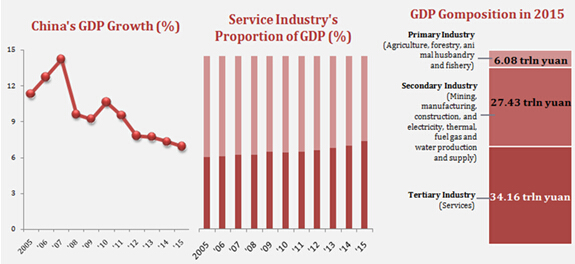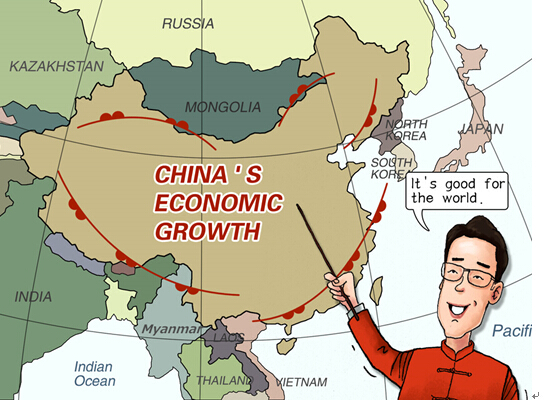Economic growth dips, yet structure improves
 0 Comment(s)
0 Comment(s) Print
Print E-mail China.org.cn, March 22, 2016
E-mail China.org.cn, March 22, 2016
China's economy expanded by 6.9 percent in 2015, down from the 7.3 percent in 2014 and recording the slowest annual growth in 25 years, according to data released by the National Bureau of Statistics (NBS) on Jan. 19.
|
|
|
Warm current |
Growth in the fourth quarter stood at 6.8 percent year-on-year, the lowest quarterly rate since the global financial crisis in 2008.
However, the NBS believes that the economy still "ran within a reasonable range" in 2015, with its structure further optimized, upgrading accelerated, new growth drivers strengthened and people's lives improved. The government had previously set the official growth target at 7 percent for the year.
Robust service shows landmark improvement in structure
China's economic structure continued to improve last year.
The service sector, for the first time, contributed more than a half of total gross domestic product (GDP) growth (50.5 percent), suggesting deepened restructuring of the national growth model.
"Rising contributions from the service sector to GDP are a natural consequence of a country's economic development after entering the late stage of industrialization," said an NBS official, stressing government efforts in the process.
The structure of demand was also improved. Expenditure from consumption contributed 66.4 percent of GDP, up by 15.6 percentage points than the previous year.
The Chinese government has gone all out to promote the service sector, hoping it will replace polluting and energy-intensive industries to become a new economic engine.
In his government work report last March, Chinese Premier Li Keqiang said China will accelerate the development of the service sector, whose great growth potential could create a huge number of jobs.
Support in the shape of fiscal, taxation, land and price policies must be implemented to stimulate the development of tourism, health care, elder care and design, said Li.
As part of the government efforts, China opened up its service sector wider to overseas investors last year by relaxing a number of investment restrictions.
President Xi Jinping reiterated the importance of the service sector at a symposium attended by ministers and provincial officials on January 18.

Rising 'world market' with impressive trade volume
Although China's imports and exports fell seven percent year-on-year in 2015, the total trade volume still reached US$3.7 trillion, with an increase in imports of major commodities. China is expected to remain the world's largest exporter and the second largest importer. Falling prices of major commodities on the international market had obvious impact, however.
The country's 13th Five-Year Plan (2016-20) will be adopted later this year, featuring relaxation of the population policy to allow a second child; combined with pressure on real estate developers to lower housing prices to create more infrastructure development, this will continuously consolidate the demographic dividend and market size, apart from expanding demand for imported raw materials.
Amid structural optimization, technological and industrial upgrading is accelerating, while consumption is expanding, all leading to larger demand for imports. Last year, total retail sales of consumer goods in China reached US$4.6 trillion, in which imported items accounted for some US$160 billion.
World's center of suppliers with optimized structure
Being the world's largest exporter and manufacturing center, Chinese exports range from clothes to solar panels, meeting international needs. Last year, the growth of China's export outpaced the global average as well as individual major economies.
Chinese exports now feature an increasingly optimized structure in terms of variety. Last year, machinery exports increased by 1.2 percent year on year, accounting for a slightly larger percentage in the country's total export volume. Made-in-China railway and electric power facilities were welcomed in many countries, including European countries and the United States.
Locomotive of the world's economic growth despite transformation
Despite the slowing economic growth rate, IMF data shows China still contributed 35 percent of global economic growth in the past five years, a figure expected to stay at 30 percent until 2020. Although China is the second largest economy in the world, its per-capita GDP is only one-fifth that of the United States, which offers much growth potential to continuously fuel world economic recovery.
The country's GDP was up by US$648.5 billion from the year before, higher than the US$470 billion of the U.S. and the US$110 billion of India.
China would certainly continue to play the role as the locomotive of the world's economic growth, said Zhang Liqun, a research fellow at the Development Research Center under the State Council.
That China's economy is vital to the world is evident from the global attention it receives, said Associated Professor Zhu Andong of Tsinghua University, reflecting the close links that now exist with the world that didn't exist before.







Go to Forum >>0 Comment(s)